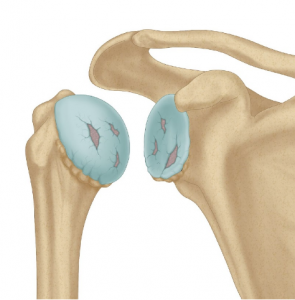COVID-19 Update – Yes we are open. Our rooms and processes have been modified to ensure your safety. Please click here to learn more.

Arthroplasty is an operation that removes the cartilage surfaces at the ends of the arm bone and the shoulder socket, and replaces them with metal and plastic components. The most common reason to perform a total shoulder replacement is shoulder arthritis.
There are two main types of shoulder replacement: anatomic replacement and a reverse shoulder replacement.
An anatomic total shoulder replacement replaces the ball at the top of the arm bone (the humeral head) with a ball made of metal, plastic or ceramic. The shoulder socket (glenoid) is replaced with a plastic liner.


A normal shoulder joint is surrounded by a number of muscles (the rotator cuff) that help control movement and keep the ball stable on the socket. These muscles must be intact and functioning for an anatomic total shoulder replacement to work properly and to prevent it from wearing out early.
In certain circumstances, only the humeral head is replaced and the glenoid is left alone. This operation is called a hemiarthroplasty.
Shoulder hemiarthroplasty is sometimes preferred in very young patients, or in patients who have a significant deformity that makes it difficult to secure a component to the glenoid.
Like an anatomic total shoulder replacement, a shoulder hemiarthroplasty needs the surrounding rotator cuff tendons to be intact and functioning in order for it to work properly and prevent it from wearing out early.
In a reverse total shoulder replacement the round ball on the top of the arm bone (the humeral head) is replaced with a socket, and the socket on the shoulder blade is replaced by a semicircular ball. This altered alignment allows the shoulder to function even when the surrounding rotator cuff tendons are unable to be repaired.


The most common reason to use a reverse total shoulder replacement is shoulder arthritis with deficient rotator cuff tendons. Other conditions that may require a reverse total shoulder replacement are shoulder arthritis with significant bone loss of the shoulder socket (glenoid); certain severe shoulder fractures; and large, irreparable rotator cuff tears.
Not every person with shoulder arthritis will need a joint replacement. A joint replacement is generally reserved for patients with arthritis that causes them persistent pain, especially pain at night and pain with attempted movement of the shoulder.
After shoulder replacement surgery it is common to stay in the hospital for a few days. You will be in a sling after surgery, and you will be seen by a physiotherapist to guide you through the exercises required to safely move your new shoulder.
Following shoulder arthroplasty, it will be some months before you are allowed to move your new shoulder without protecting it.
The main goal of a shoulder arthroplasty operation is to reduce the level of pain in your shoulder. It is important to realise that even though your pain is much better, your new shoulder may still not have a normal range of movement.
For more information on arthroplasty, we recommend contacting our surgeons for an initial consultation.